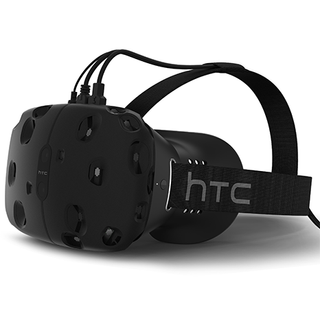Oculus Rift Vs. HTC Vive Vs. PlayStation VR
The Oculus Rift and HTC's Vive are now available and later this year, Sony's Playstation VR is coming out. This guide offers a comparison between the three and will help you device which VR system is right for you.
Tracking Systems And Controls
Now that we've covered the three HMD's visuals, optics, FoV, design, ergonomics, audio systems, and extra features, we can move on to the last two important hardware specifications that need to be compared: the tracking systems and controllers included with each VR system.
When it comes to presence, after the visuals, accurate sub-millimeter 6 DOF (degrees of freedom) tracking is the next most important feature. For the uninitiated, when we say 6 DOF tracking, we are referring to full position tracking that not only tracks the orientation of your head as you look around but also its translation in space along the x, y and z-axis. This makes the visuals in VR appear as they would in reality, no matter where your head is positioned.
The lack of positional tracking on mobile VR systems (they only track orientation) is one of the reasons why they lack the sense of immersion that high-end VR offers. Good tracking relies on external sensors (like the Rift's camera), something that's not feasible on a mobile device. The three VR systems we are comparing each use different technology for their tracking systems, with both the Rift and PlayStation VR using a camera-based optical system and the Vive using lasers.
Because we've been comparing the PSVR bundle throughout this article, the required PlayStation Camera for tracking is included, but it's important to note that you can buy the PSVR alone without the camera (the logic here is that some customers already have the PlayStation Camera).
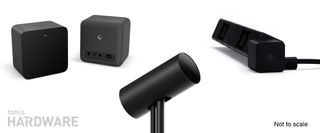
Tracking System Specifications
| Header Cell - Column 0 | HTC Vive | Oculus Rift | PlayStation VR |
|---|---|---|---|
| Tracking Hardware | "Lighthouse" Base Stations (2) | Constellation Camera | PlayStation Camera(dual camera with depth perception) |
| Tracking Technology | IMU, IR Laser-based 360-degree tracking | IMU, Optical 360-degreeIR LED tracking | IMU, Optical 360-degree LED tracking |
| Headset Tracking Hardware | 32 PhotodiodeSensors | 44 IR LEDs(10 on rear of HMD) | 9 LEDs |
| System Latency | TBA | TBA | < 18 ms |
| Tracking FoV | 120H x 120V-degreesx 2 | ~100H x 70V-degrees | ~72H x 45V-degrees |
| Max Tracking Distance, Cable Limited (with slack to turn) | ~4.5 m* | ~2.5 m* | ~3 m* |
| Camera Tracking Dead Zone | N/A | 90 cm | 60 cm |
| VR Play Styles Supported | Seated, standing, room-scale | Seated, standing,room-scale TBA (with unreleased Touchcontrollers and 2nd camera) | Seated, standing, room-scale |
| Room-scaletracking area | Min: 3 m²Max: 5 m diagonal,12 m² | Max: 3.9 m² | Max: 4.56 m² |
| Chaperone System | Yes | No | Yes (limited) |
(* Calculations to arrive at this result: Vive – 6 m cable length (including Link Box cables) minus 1 m slack and 50 cm from back of PC to Link Box. Rift – 4 m cable length minus 1 m slack and 50 cm from back to front of PC. PSVR – Sony stated maximum tracking distance)
Lasers Versus Cameras, Inside Versus Out
Even though all three systems rely on external components to track the headsets (and with the Vive and PSVR, the controllers too), the way the HTC Vive handles tracking is appreciably different. We're not just talking about the fact that it uses lasers either; Valve and HTC have taken a fundamentally different approach to this critical VR headset feature.
It's also important to remember that the external tracking systems aren't the only component used for tracking. Each of the headsets has inertial measurement units (IMU) that combine accelerometers and gyroscopes to provide additional tracking data to the system. It's this fusion of all the sensory data provided by the different systems that allow all three headsets to deliver the fast and accurate tracking needed for presence.
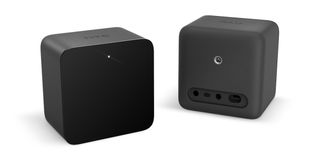
The two "Lighthouse" base stations above are the key component of the Vive's tracking system and the way they work, while technically quite simple, is very innovative and was invented by Valve's "Chief Pharologist," Alan Yates. These base stations need to be mounted preferably two meters above the floor (or higher, though they can still work if mounted lower) in opposite corners of the room, angled down 30-45-degrees, so their 120-degree FoV (Field of View) has the maximum amount of play space coverage. If you are only planning to use the Vive for seated or standing VR experiences, you can mount both in front of you, but it's not something HTC recommends.
Although the base stations need to be synced together via Bluetooth (or the included sync cable) and require power, they are not connected to your PC or the HMD. Unlike the camera sensors of the other systems that track markers on the headsets, the Vive base stations send out IR structured light laser beams that are tracked by sensors on the HMD, and it's that data (along with information from the IMUs too) that gets sent to the PC to be processed.
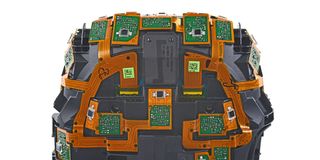
The image above from iFixit’s HTC Vive Teardown shows some of the 32 photodiode sensors that reside below the small windows that pepper the outer shell of the Vive's face mask. To be more specific, the base stations send out an omnidirectional flash using IR LEDs sixty times a second. That is picked up by the HMD's photodiodes, which tells them to start counting. Then one of the structured light lasers sweeps across the room (there are two, one sweeps vertically and one horizontally), which takes 10 ms. When one of the sensors is hit by a laser, its position can be determined by how long it took for the laser to strike it and where it is located on the headset. In the next 10 ms, the IR LEDs flash again and the second laser sweeps the space.
Although Alan Yates has said that one base station is the minimum required to track an HMD that also has IMUs, and only five sensors need to be visible to it to acquire the headset's position, the Vive uses two. For the 360-degree tracking necessary for the Vive's room-scale VR, a single base station would have problems with occlusion where the HMD's sensors wouldn't be visible if you weren't facing it. That is unless there were some on the back of the headset, which is not the case with the Vive.
The Vive's tracking system is clearly more advanced, and from our experience it's the best solution available right now. When used with the IMUs the Vive's tracking has very low tracking latency, which is crucial in preventing nausea in VR. Because it uses lasers, precise submillimeter tracking is possible even at long distances, which allows the Vive to support the biggest play space of all three systems. It is even technically possible to use more than two base stations to support even larger play areas, but this isn't something that is supported yet.
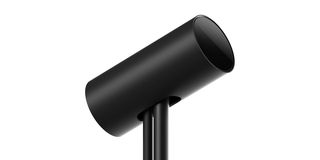
In comparison, the Rift's tracking system is a lot easier to set up. There's just the Constellation camera that has to be hooked up to one of your PC's USB 3.0 ports and placed on your desk in front of you (you can also mount it somewhere else on any 1/4-inch thread stand or tripod). If it's on your desk, you need to angle it facing upwards, so its narrower FoV (100H x 70V-degrees) is able to track enough volume to cover you whether you are playing, seated or standing.
Because the Rift uses a camera for tracking, its limitations compared to the Vive's Lighthouse system are immediately apparent. Unlike the lasers of the Vive's base station, the tracking range of a camera is going to be limited by both its optics and image resolution. There will be a point where the headset is too far away for it to resolve enough detail to track accurately. Also, your PC has to do a lot more work processing the image data to extract the HMD's position from it, potentially taking processing cycles away that could be used to improve VR performance in other areas. There is a dead zone of 90 cm in front of the camera where it cannot track the HMD, likely because it can't focus properly on the headset.
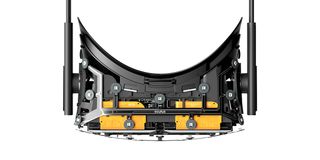
The way that the Rift's tracking works is that the HMD is covered in 44 IR LEDs, on the front, top, bottom, sides, and back. They are invisible when you look at the headset, but the fabric covering it allows IR light through, so the camera can see them. The feed from the camera shows where the LEDs are positioned, with the pattern they are arranged in also helping to determine orientation. How large the LEDs appear on camera helps determine how far away the headset is.
The data from the LED positions is, like the Vive, combined with information from the Rift's IMU, and despite some of the disadvantages we listed above, when it comes to accuracy and latency the Rift's system is just as good as the Vive's. Also, even though it only uses one camera, a full 360-degrees of motion can be tracked because the Rift has 10 IR LEDs on the back of its head strap.

One of the big differences between the PlayStation VR's tracking system and the other two is that instead of designing new hardware to enable it, Sony has decided to use the existing PlayStation Camera for positional tracking. In addition, the system incorporates technology from Sony's PlayStation Move controllers, originally released for the PS3 in 2009, which shows how good the Move technology must be to still be viable seven years later! Up until now, this $60 camera hasn't exactly been wildly successful, with only 19 games released for the PS4 that use it, so it's not likely many PlayStation owners have one.
The other significant difference is that the PlayStation Camera has two cameras for stereo depth perception, something neither of the other two tracking systems can do. Like the Rift, PlayStation VR tracks LED lights (this time visible ones rather than IR) on the headset that are arranged in a pattern that covers all sides and the back of the HMD for full 360-degree tracking. However, unlike the multiple small LEDs on the Rift, the PSVR headset only has 9 LEDs, but they are shaped in such a way that their orientation can be determined by the camera, and the stereo depth perception can work out their position.
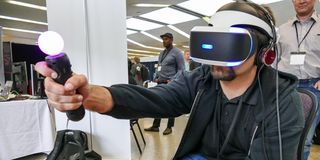
Again, the data from this optical tracking is combined with data from an IMU in the headset for low latency submillimeter accurate tracking. However, our impressions of PlayStation VR's tracking was that it had just a bit more latency than the PC-based headsets, although because it doesn't come out until the fall, this may be something that is addressed before launch. Also, like the Rift, there is a dead zone of 60 cm in front of the camera where it cannot track, and if you look at our tracking area diagram below, because of the narrow FoV of the PlayStation Camera, there is another 90 cm where the tracking space is reduced. Suffice it to say, for the best VR experience you are going to want to be at least 1.5 m away from the camera.
Tracking Limits And Play Areas Compared
One of the main questions is the size of the play areas for each of the three systems. Because the Vive has from the very beginning been promoted as a VR system that supports full room-scale VR, its technology is designed to support the largest play area possible, which the diagram below makes clear. However, even though both the Rift and PlayStation VR have only been promoted using seated or standing VR experiences, that is not to say that they aren't capable of supporting larger play spaces, as you can see below. Indeed, at this year's GDC, Sony officially confirmed that the PSVR will support room-scale VR, albeit within the much smaller area shown below. As of now, Oculus has not said the current incarnation of the Rift will support room-scale; that will come when its Touch motion controls launch later in the year. What you see in yellow below is based on our own calculations.
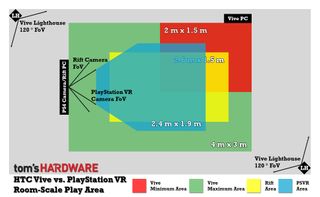
Let's go over how we came up with the data presented above, and also why some of the figures differ a little from the "Max Tracking Distance" in our specification table shown earlier on this page. Those numbers take into consideration both the ~50 cm of cable lost to plugging it into the back of your PC and 1 m of slack cable running down from the headset, so you have enough to turn 360 degrees. In the diagram above, the Vive dimensions are based on HTC's specifications, with 5 m diagonally considered the maximum, which doesn't leave you with much slack cable to work with when you get close to the limits. Keep in mind, the horizontal FoV of both the Vive and Rift tracking systems are able to cover the majority of the "room" above. Therefore, the rectangular shape of the Vive and Rift play area coverage can be a different aspect ratio, as long as the area is the same in m² and the cable limitations aren't exceeded.
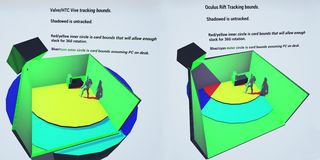
In fact, cable limitations and the slack needed for freedom of movement define the play space more so than the tracking sensors do, as can be seen in the 3D visualizations above, depicting the Vive and Rift tracking bounds as provided by Reddit user Muchcharles from this discussion. There can be quite a difference in the maximum area available and the area that allows for full freedom of movement. It also shows how much smaller the Rift's tracking bounds are, which we also show in our diagram. Not only does the Rift have the shortest HMD cable of the three systems, but it also doesn't have a breakout box, so you lose ~50 cm right off the bat (if you turn your PC around so the HDMI port faces outwards, you can regain that length).
Our diagram shows the extent of the Rift's play area with the cable close to its limits like the maximum Vive area shown. Because its cable is such a limiting factor let's hope that when Touch is available, Oculus provides a longer HMD cable for the Rift with it too. For PlayStation VR, we used Sony's room-scale dimensions from its GDC presentation, which showed a maximum distance of 3 m from the camera.
The Controls In The Box
Now it's time to talk about the controllers and for the purpose of this section we are only going to cover what's included in the box if you were to buy or pre-order any of the three systems today. That means we're not going to discuss Oculus' Touch motion controls, and we are including the PlayStation VR bundle that comes with the Move controllers.

Controller Specifications
| Header Cell - Column 0 | HTC Vive | Oculus Rift | PlayStation VR |
|---|---|---|---|
| Controller | Vive Controller | Xbox One Controller with Wireless Adapter for Windows | PlayStation Move Controller |
| Tracked | Yes, with “Lighthouse” laser Base Stations | No | Yes, optical with PlayStation Camera |
| Connectivity | Wireless (proprietary protocol) | Wireless (proprietary protocol), wired | Wireless (Bluetooth) |
| Input | Analog trigger, grip buttons, touchpad/d-pad, menu button, system button | 2 analog triggers, 2 analog sticks, d-pad, 8 game buttons, menu button, view button, home button | Analog trigger, 4 game buttons, start button, select button, home button, move button |
| Haptic Feedback | Yes | Yes | Yes |
| Battery | Internal Lithium Polymer (LiPo) battery pack (mAh unknown) | AA batteries (included), optional rechargeable battery | Internal Lithium-ion (Li-ion) battery pack (1320 mAh) |
| Battery Life | 5+ hours | ~30 hours with rechargeable battery | ~10 hours |
| Charger Included | Yes | No | No (only cable) |
| Charging Port | Micro USB | Micro USB | Mini USB |
| Materials | Plastic | Plastic | Plastic |
| Dimensions | ~220 mm x ~118 mm | 152 mm x 102 mm | 200 mm x 46 mm |
| Weight | 207g | 280g | 145g |
Of the three, only the HTC Vive comes with tracked controllers that were specifically designed for use in VR (two Vive Controllers). At the moment the Rift does not have a tracked controller solution, so it ships with a wireless Xbox One controller that we think is far from ideal. PlayStation VR's two Move controllers, although originally released in 2009, are surprisingly suited for use as tracked VR controllers and come close in functionality to the Vive's excellent units.

The wireless Vive Controller is a wand-like controller with a ring at its top that contains the tracking sensors. Ergonomically they are very comfortable, but it still does feel like you are holding a stick in each of your hands, which for some in-VR interactions doesn't feel as natural. The controller has two buttons on its face: a menu button and a system button, that when double-pressed activates the Tron-like room view (Chaperone) using the HMD's camera. Underneath is an analog trigger, which, in our experience, is what is used for the majority of interactions in the current crop of Vive games. On the side are two grip buttons that are used by squeezing the controller in your hand. The last interactive element is the circular touchpad that functions similar to the pad on the Valve's Steam Controller. It can either be used as a true touchpad, a d-pad or quadrants of it can be assigned to act as buttons.
The beauty of the Steam VR controllers is that they are fully tracked with the same level of accuracy and latency as the headset. As you can see in the image below (also from iFixit's HTC Vive Teardown), there are 24 photodiode sensors dotting the ring at the top of the controller so that it can be tracked from any orientation. The sensors are smartly placed around the ring so that there is little chance of occlusion no matter what angle you hold the controller. Data from these sensors is also sent back to the PC along with data from the controller IMU for additional orientation information.

With this precise positional information, the Vive's controllers often feel like extensions of your hands in VR, rather than abstract devices (like game controllers) you have to learn how to use. To interact with the virtual world, all you have to do is reach out for something instead of pressing a button, and your actions soon become instinctive. Even though you need to use the trigger, the controllers become almost invisible, with their excellent haptic feedback further enhancing the experience. The only negative is that the five-hour battery life is substantially less than that of the other systems' controllers.
Although the Steam VR controllers are the primary tools used for interaction in most of the Vive games that have been released so far, you can still use other kinds of controllers with the Vive system. For seated and standing VR experiences that don't need motion controllers, you can use a standard gamepad, and for driving or flight simulators you can use a racing wheel or HOTAS setup. Another benefit of the Vive camera is that it makes it easy to see where these untracked controllers are once you have the headset on.
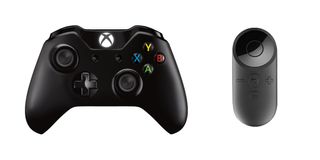
There isn't really that much we can say about the Rift's primary controller. It's the same Xbox One controller that most of you are probably very familiar with. Oculus includes the wireless adapter for your PC but not the optional rechargeable battery, which is disappointing. Along with buttons and joysticks being used for the same kind of in-game VR control as in flat games (the Rift doesn't track it in any way), the Xbox One controller can be used to navigate the Rift's menus too, but it isn't ideal for that purpose. That's why Oculus also included a handy remote (shown to the right above). The remote can be used to navigate menus, control media playback (it has volume controls), and even play some games. There are some titles available for the Rift that are ports of Gear VR games (such as EVE: Gunjack) that have much simpler control schemes, and you can use the Remote for them. The lack of tracked motion controllers in the box is probably the biggest disappointment of the Rift.
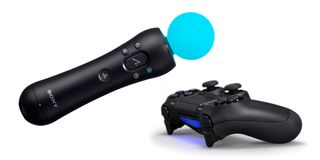
OK, so we've cheated a little in the image above. PlayStation VR doesn't come with a Dualshock 4 controller in the box, but we wanted to include it here because every PSVR owner will, of course, have at least one. This is important because unlike the Xbox One controller that comes with the Rift, the PSVR's camera can track the controller. On the front of the Dualshock 4 is an LED that can be tracked along with data from the controller IMU, which means that it will have the unique functionality of being a hybrid VR controller, combining traditional buttons and sticks with motion control. How it will be utilized in games remains to be seen, though, since we haven't tried any PlayStation VR demos that use it.
The choice to use the PlayStation Move controllers with PSVR is both inspired and odd. Inspired in that VR has made a game peripheral from 2009 relevant again (only one Move-compatible PS4 game has been released). Odd in the sense that while the Move controller does work well as a tracked VR controller, it was never designed with VR in mind. That means its wand-style ergonomics don’t exactly lend themselves as well to the Move controllers feeling like your hands in VR.
The glowing orb that sits on top of it is what the camera tracks, and because it’s circular, orientation data will have to come from the controller IMU. For PSVR room-scale VR, the single point of tracking along with the single tracking camera means there is likely to be some occlusion. Despite that, we applaud Sony for including proper motion controllers out of the (bundle) box, and the 10-hour battery life is a lot better than the Vive controllers.
What About Oculus Touch?
There is a silver lining for those who decide to go with Oculus’ VR offering. The Touch tracked motion controllers are excellent and in our early experience with them, perhaps even better than the Vive controllers. Unfortunately, they will not be available until the second half of 2016 at the earliest, and we have no idea what they’ll cost.
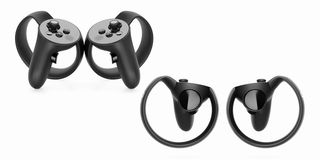
Like the Vive controllers, the Touch controllers are fully tracked, and the outside of the ring-shaped area has the same IR LEDs as the HMD for the Constellation camera to track. Because occlusion will be an issue with a single tracking camera, Oculus will provide a second camera to use with Touch. Until now, Oculus has shown this second camera positioned in front of the player too, which is not an optimal setup for room-scale VR, and the demos we’ve tried, such as Toy Box (shown in the video below) have mostly been standing 180-degree experiences. This isn’t to say that with Touch and the second camera that room-scale VR won’t be possible, but there are other hurdles that need to be crossed first, such as cable length restrictions.
The Touch controllers also have a few unique tricks up their sleeves. The first is that the reason for the ring-shaped design, other than somewhere to place the tracking LEDs, is that the inside of the ring also has sensors to do finger tracking. That means you can make a gesture like pointing at something, and the controller will pick it up and display it in VR. This becomes especially useful for social VR gaming where players can communicate non-verbally using this feature. The other feature is that the buttons, thumb sticks, and triggers are also touch-sensitive, so the controller knows when your fingers are touching them, which will let you know in VR where your fingers are positioned on the controller.
In addition to these unique features, the ergonomics of the Touch controllers is superior to both the Vive controllers and PlayStation Move controllers. They are very comfortable to hold, and your hands are angled more naturally. Your fingers have more freedom, so when you reach out to grab something in VR it feels more immersive.
Current page: Tracking Systems And Controls
Prev Page Audio Visual Experience And Other Features Next Page Safety, Software And ComfortStay on the Cutting Edge
Join the experts who read Tom's Hardware for the inside track on enthusiast PC tech news — and have for over 25 years. We'll send breaking news and in-depth reviews of CPUs, GPUs, AI, maker hardware and more straight to your inbox.
-
nitrium Apparently the PSVR has already been hacked to work on PCs (and Sony is considering official PC support after launch) - I wonder if it might be the best headset to get IF you have a PC, given that from this article at least the number one issue with PSVR is the PS4 it's being attached to.Reply -
problematiq I feel the PSVR got a bit over hyped in this article, in all fairness though it's not released yet so not a lot to go on. As an owner of the HTC Vive I can say "Yes your face will get warm/sweaty if you are in a warm room". I keep a fan blowing tword the center of the room to fix that problem, plus it makes me feel like I'm feeling the wind in VR. o.o All in all was the best purchase I've made in sometime. My wife who does not really like to play games enjoys it A LOT. It is also just a really hard experience to describe other than "Awesome". I don't know how I would feel without the full room scale and motion controllers, I think it would feel novel like playing games in 3D, sure it's cool but not practical and after a while your glasses sit there gathering dust. The ability to reach over and more or less grab and object, play around with it and even toss it, I'm just not sure how I could take off the HMD and put on the Rift and have an experience as good as that of the Vive. All of the HMD's are heading twords the same goal in the end though and it's evident.Reply -
Jeff Fx >and they don't have low refresh rate displaysReply
I think you wrote "low" when you meant "high." -
Zapin So comparing one currently non-existant HMD to two others (one of which is still an incomplete experience) that run on a totally separate platform? Makes sense to me.Reply -
picture_perfect Wait for Polaris / Pascal cards later this month which will be 2X faster in VR apps. Well that is the Nvidia claim. Other VR specifics mentioned like (ray trace audio, specialized projection ect.). These are the first "VR cards".Reply -
Sven Viking The C:-drive-only issue was fixed a while ago, by the way, though (for now at least) you still need to choose one drive and stick to it rather than being able to split games between drives.Reply
For international pricing, don't forget to take high shipping costs and (for Vive to AU/NZ at least) customs fees into account. -
problematiq Reply17976471 said:Wait for Polaris / Pascal cards later this month which will be 2X faster in VR apps. Well that is the Nvidia claim. Other VR specifics mentioned like (ray trace audio, specialized projection ect.). These are the first "VR cards".
I run a 980 TI with the Vive and my load barely see's 30% I'm not sure what you are gaining for waiting on a "VR Card" -
Deric_ How can PSVR do roomscale with only a single camera?Reply
Your controllers will get occluded everytime your body is between them and the camera.
If you have to face a single direction to play, then it is not room scale. -
alex davies ReplyApparently the PSVR has already been hacked to work on PCs (and Sony is considering official PC support after launch) - I wonder if it might be the best headset to get IF you have a PC, given that from this article at least the number one issue with PSVR is the PS4 it's being attached to.
A PC-compatible PSVR would only be the best VR headset from a price perspective. Yes, having a PC power it would improve the fidelity of the in-game graphics, but despite being the most ergonomic, it's still a step below both the Rift and Vive technically. Well, Rift + Touch, because as the moment the lack of tracked controllers handicaps the Rift. -
alex davies Reply>and they don't have low refresh rate displays
I think you wrote "low" when you meant "high."
Fixed, thanks!
